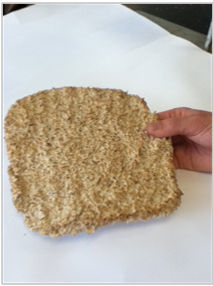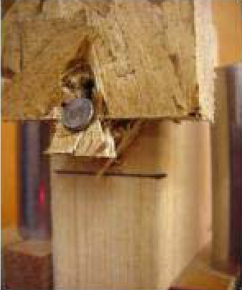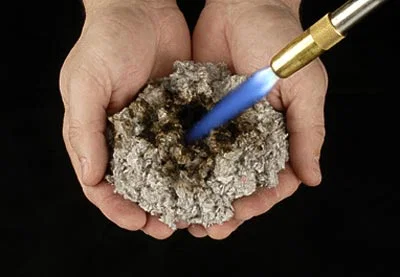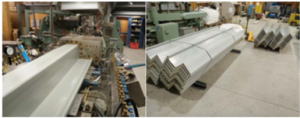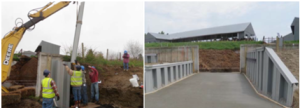25% Stronger, 100% Biobased Fiber Board
By replacing commonly used formaldehyde-based resins with a new type of binder, researchers at UMaine have developed fiber board building material that is nontoxic, made entirely from renewable materials and is 25% stronger than currently available products. The new binder includes cellulose nanofibrils (CNF), which are wood fibers about 200 micrometers in length and 30 nanometers wide. The CNF is manufactured using a UMaine proprietary mechanical process that is free from harmful chemicals or additives.
Benefits:
- Reduction in health problems and related expenses (up to $48m per year 1) caused by formaldehyde exposure.
- Up to 25% increased product strength.
- All components, precursors and processing materials are renewable and nontoxic.
Reinforcement system increases wall panel strength by 20%
When stressed, oriented strand board (OSB) panels tend to fail along the edges and at nail sites, particularly if the panel has gotten wet. This technology presents a system for waterproofing and reinforcing panel edges. The reinforced edge improves fastener performance and reduces the edge swell and weakening caused by moisture exposure. Reinforced edges strengthen the panel by up to 20%.
UMaine Reference: 2005-07
Patents:
(US 6,699,575 issued Mar 2, 2004)
US 7,547,470 issued Jun 16, 2009
Inventors: Douglas J. Gardner, Stephen M. Shaler, Lech Muszynski, Ciprian Pirvu, Jungil Son
Composite Panels for Blast and Ballistic Protection

The Modular Ballistic Protection System (MBPS) provides soldiers with enhanced ballistic protection where it never existed before – in their tents where they work, eat, and sleep. The system consists of composite ballistic panels that are mounted to the inside of the tent frame using an energy-absorbing connection system. Requiring no tools, the MBPS can be used to up-armor a 20ft x 32ft tent in less than 30 minutes with 4 soldiers.
US Patent 7,68,5921
Bridge in a Backpack®

The Bridge-in-a-Backpack is a lightweight, corrosion resistant system for short to medium span bridge construction using FRP composite arch tubes that act as reinforcement and formwork for cast-in-place concrete. The arches are easily transportable, rapidly deployable and do not require the heavy equipment or large crews needed to handle the weight of traditional construction materials.
To date six Maine bridges have been built using the Bridge-in-a-Backpack technology. Several bridge projects are planned for 2012 throughout New England and beyond.
UMaine Tech ID 2005-14
US Patent Number 7,811,495
Additional US and International Patents Pending
Exclusively Licensed to Advanced Infrastructure Technologies
Fire Resistant Cellulose Insulation
End users and installers of insulation want a product that is affordable, efficient and safe. Cellulose insulation, generally produced from recycled wood fiber, is affordable and outperforms fiberglass in extreme weather. But cellulose has poor insect resistance and fire retardant qualities without the addition of toxic chemicals. Additionally, the cellulose insulation manufacturing process currently used creates a product prone to settling, which is bad for the homeowner, and dust, which is bad for the installer. ProCell Insulation solves all of these problems, making it a very attractive choice compared to fiberglass and other cellulose insulation brands.
The technology was developed at UMaine in collaboration with the company founders. Company is currently developing manufacturing and distribution networks. Learn more at procellinsulation.com
UMaine Tech ID 2009-34
US Patent Number 8,043,384
Netforms Pre-Fab Roofing Panels Reduce Construction and Heating Costs

PROBLEM: Insulated, ventilated roofs, particularly those covering open floor plans and cathedral ceilings, are difficult and expensive to build.
SOLUTION: These economical prefabricated panels incorporate wood I-joist framing, OSB sheathing, insulation and ventilation into a single product to be used in light-frame construction applications.
TECH ID: 2008-34
PATENT: US 8,046,969; US 8,141,313
LINK:
DEVELOPMENT PLAN: Undetermined. Has been successfully demonstrated, but on hold given the current downturn in construction.
New Composites Made from up to 60% Inexpensive, Raw Plant Material
PROBLEM: Composite manufacturers need ways to improve extruded thermoplastics using inexpensive, environmentally friendly ingredients and without slowing process time.
Low Maintainance Sheet Piling Reduces Life Cycle Costs of Retaining Walls
PROBLEM: Commonly available sheet piling used for retaining walls corrodes, increasing maintenance costs and reducing the useful life of the construction. These problems are heightened in a marine environment.
SOLUTION: Our patented wood composite sheet piling system does not corrode, which reduces overall life cycle costs. Additionally it is chemically inert and 100% recyclable.
Fire Proof Paint
A fire resistant paint includes a film-forming binder, a solvent, and a hydrated mineral that imparts fire resistance to the paint. The paint, when applied to a fibrous composite article which comprises at least about 20 wt % lignocellulosic fibers bound together into a consolidated fibrous article, provides the article with a flame spread index of not greater than about 50.
Inventors: Mike Bilodeau, Mark Paradis
atent Pending, Canada and US 13/061,583
UMaine Reference: 2008-26
Contact Kris Burton
38% Stronger Reinforced Glulam Construction Beams

PROBLEM: Builders prefer reinforced glulam beams for applications benefiting from thier beauty or shape versatility. But glulam beams have a tendency to weaken (delaminate, or peel) on the ends when the center of the beam is bent or stressed.
SOLUTION: UMaine offers reinforced glulam beams that withstand end delamination under 38% more bending stress compared to other reinforced beams, and 95% more stress compared to non-reinforced beams.

